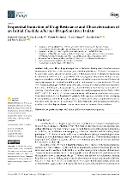Sequential Induction of Drug Resistance and Characterization of an Initial Candida albicans Drug-Sensitive Isolate

Author
El Hachem, Setrida
Fattouh, Nour
Chedraoui, Christy
Publication date
2024Published in
Journal of FungiVolume / Issue
10 (5)ISBN / ISSN
ISSN: 2309-608XISBN / ISSN
eISSN: 2309-608XMetadata
Show full item recordCollections
This publication has a published version with DOI 10.3390/jof10050347
Abstract
BACKGROUND: The pathogenic fungus Candida albicans is a leading agent of death in immunocompromised individuals with a growing trend of antifungal resistance. METHODS: The purpose is to induce resistance to drugs in a sensitive C. albicans strain followed by whole-genome sequencing to determine mechanisms of resistance. Strains will be assayed for pathogenicity attributes such as ergosterol and chitin content, growth rate, virulence, and biofilm formation. RESULTS: We observed sequential increases in ergosterol and chitin content in fluconazole-resistant isolates by 78% and 44%. Surface thickening prevents the entry of the drug, resulting in resistance. Resistance imposed a fitness trade-off that led to reduced growth rates, biofilm formation, and virulence in our isolates. Sequencing revealed mutations in genes involved in resistance and pathogenicity such as ERG11, CHS3, GSC2, CDR2, CRZ2, and MSH2. We observed an increase in the number of mutations in key genes with a sequential increase in drug-selective pressures as the organism increased its odds of adapting to inhospitable environments. In ALS4, we observed two mutations in the susceptible strain and five mutations in the resistant strain. CONCLUSION: This is the first study to induce resistance followed by genotypic and phenotypic analysis of isolates to determine mechanisms of drug resistance.
Keywords
biofilm, chitin, drug resistance, ergosterol, whole-genome sequencing
Permanent link
https://hdl.handle.net/20.500.14178/2492License
Full text of this result is licensed under: Creative Commons Uveďte původ 4.0 International







